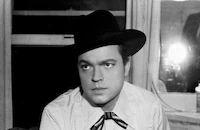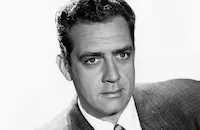Black Magic

Brief Synopsis
Cast & Crew
Gregory Ratoff
Orson Welles
Nancy Guild
Akim Tamiroff
Frank Latimore
Valentina Cortese
Film Details
Technical Specs

Synopsis
Writer Alexandre Dumas, Sr., obsessed by the subject of his new book about Cagliostro, the infamous 18th century sorcerer, recounts the following story to his son, Dumas, Jr.: Cagliostro, who began his life as Joseph Balsamo, was the son of gypsies. When his mother, gifted with clairvoyance, is accused along with his father of forging an alliance with the devil, they are sentenced to hang by Count DeMontagne, who also orders the boy to be whipped and his eyes put out after watching his parents' execution. Just as the guards are about to sear Joseph's eyes with a hot poker, a band of gypsies led by Gitano comes to his rescue, after which Joseph vows revenge on DeMontagne. Years later in Vienna, Joseph, now known as the Great Balsamo, presides over a show of fakery and black magic at the gypsy carnival. At the carnival, Joseph peddles bottles filled with the "elixir of life," and when a customer goes into convulsions after drinking a bottle mistakenly filled with lamp fluid, Joseph hypnotizes her into believing that she has no pain. Later, Dr. Franz Anton Mesmer, a member of the medical faculty at the University of Vienna, interviews the woman and discovers that Joseph does indeed possess some power over the mind. Dr. Mesmer then visits Joseph and Gitano, who have been arrested, and arranges for their release in hopes that Joseph can help him achieve scientific recognition for his discovery of the curative properties of hypnotism. After Joseph cures one of Mesmer's wealthy patients of palsy, the doctor suggests that he and Joseph become partners to aid humanity, but instead, Joseph decides to employ his gifts in the accumulation of wealth and power. Joseph then informs Gitano and Zoraida, his lover, that he is changing his name to Cagliostro, the name of the swiftest comet in the night sky. "Count" Cagliostro sweeps through Europe, and, playing on hysterical faith and emotional instability, uses his hypnotic powers to sell himself as an all-powerful healer. Compelled by memories of his youth, Cagliostro returns to France and once again encounters DeMontagne when the count summons him to examine Lorenza, a beautiful young woman suffering from shock. Under hypnosis, Lorenza, who bears a striking resemblance to Princess Marie Antoinette, recounts that while in Strasbourg, she was courted by Gilbert, a dashing young officer in the royal guards. Continuing in a trance, Lorenza recalls being snatched from her lover's arms. Unknown to Lorenza, her abduction was arranged by DeMontagne, who intends to use her in a plot against the princess, Now aware that DeMontagne is conspiring to use Lorenza to reach new heights of power, Cagliostro tells the count that she must remain under his care or die and insists upon becoming partners with him. As Cagliostro accompanies Lorenza to Paris, Gilbert searches in vain for his lost love. Although he is denounced as a charlatan by legitimate doctors, Cagliostro becomes the rage in Paris. There, Zoraida becomes insanely jealous of Lorenza, who has fallen completely under Calgiostro's power. One night, DeMontagne brings his co-conspirator, Mme. Du Barry, the mistress of King Louis XV, to see Lorenza. Du Barry is amazed by Lorenza's likeness to Marie Antoinette, whom she is scheming to discredit. Plotting to drive Marie into exile, Du Barry plans to have Lorenza impersonate the princess and buy an exorbitant diamond necklace from the jeweler Boehmer, knowing that such flagrant extravagance will inflame the starving masses of Paris and thus force the king into banishing Marie Antoinette to avoid bloodshed. Gilbert, meanwhile, has traced Lorenza to Cagliostro's house and carries her away to a safe refuge. Upon discovering that Lorenza has fled with Gilbert, Cagliostro tracks her down and marries the still hypnotized young woman to insure that Gilbert will never have her. Before Du Barry can carry out her plot, King Louis XV dies unexpectedly. Now, as Queen of France, Marie Antoinette banishes Du Barry from Paris and orders Cagliostro to leave the country within a week. Afterward, DeMontagne comes to Cagliostro's house to claim Lorenza, and Cagliostro convinces him that Lorenza has committed suicide by drinking poison. After witnessing Lorenza's internment in a garden grave, DeMontagne leaves and when Cagliostro revives Lorenza from her deep hypnotic state, she calls out for Gilbert. Driven by jealousy and revenge, Cagliostro conceives of a plot to rock the throne of France. After sending DeMontagne a letter, supposedly from Marie Antoinette, asking him to meet her, Cagliostro hypnotizes Lorenza into impersonating the queen. At their rendezvous, Lorenza, posing as Marie Antoinette, tells DeMontagne that she is in love with him and asks him to buy her the diamond necklace as proof of her love and bring it to her apartment the following midnight. Cagliostro then spreads word throughout the slums that DeMontagne has plundered public funds to buy a necklace for the queen, thus inciting the mob to riot. Cagliostro then insures Gilbert's entrapment by sending him to interrupt the rendezvous. When Gilbert arrives at the palace to demand that DeMontagne return the necklace, the queen orders them both arrested, along with Cagliostro. In prison, Cagliostro hypnotizes DeMontagne, reminds him of his parents' execution and then orders him to hang himself. Still angry over being spurned by her lover, Zoraida brings Lorenza to Marie Antoinette and reveals Cagliostro's plot. Lorenza agrees to testify against Cagliostro, but at the trial, Cagliostro hypnotizes her into stating that she knows nothing. Then, challenging the queen's motives, Cagliostro accuses Marie Antoinette of conducting an inquisition, thus rallying public support behind him. Maddened by power, Cagliostro hypnotizes Gilbert into testifying against the queen just as Mesmer bursts into the chambers and uses the necklace to hypnotize Cagliostro into confessing. Awakening from his trance, Cagliostro realizes that he has lost all. When Gitano passes him a gun, Cagliostro shoots Mesmer and escapes with the hypnotized Lorenza. Gilbert pursues them up a turret of the building, and as the crowd gapes from below, pulls his sword and fatally wounds Cagliostro, sending him plunging to his death. Freed from Cagliostro's evil spell, Lorenza rushes into Gilbert's arms.

Director

Gregory Ratoff
Cast

Orson Welles
Nancy Guild

Akim Tamiroff
Frank Latimore

Valentina Cortese

Margot Grahame
Stephen Bekassy

Berry Kroeger

Raymond Burr

Gregory Gay
Charles Goldner
Lee Kresel
Robert Atkins
Nicholas Bruce
Franco Corsaro
Aniello Mele
Ronald Adam
Bruce Belfrage
Alexander Danaroff
Leon Lenoir
Tamara Shayne
Giovanni Van Hulzen
Peter Trent
Giuseppe Varni
Tatiana Pavlowa
Crew
Georges Annenkoff
Ubaldo Arata
Charles Bennett
Anchise Brizzi
Gino Brosio
Jerome Cappi
Don Cash
Frank Cleverly
Arrigo Colombo
Jean D'eaubonne
Tonino Delli Colli
Rolf Epstein
Fred Feitshans
Peter Handford
James Mckay
Nino Novarese
Dr. Giorgio Papi
Gregory Ratoff
Dario Sabatello
Paul Sawtell
Richard Schayer
Ottavio Scotti
Edward Small

Videos
Movie Clip





Film Details
Technical Specs

Quotes
Trivia
Notes
This film's working title was Cagliostro. Valentina Cortesa's named was misspelled in the onscreen credits as "Cortese." Although the onscreen credits only acknowledge Alexandre Dumas, pére's 1846-48 novel Mémoires d'un médecin as the film's source, it was also based, in part, on his novel Le Collier de la Reine (1849-50).
Cagliostro was born Giuseppe Balsamo on June 2, 1743 in Palermo, Sicily and died in prison on August 26, 1795. The son of poor parents, Cagliostro grew up as an urchin in the streets of Palermo. Escaping from Sicily after a series of minor crimes, he assumed the title of count and married the Roman beauty, Lorenza Feliciani. He then traveled to all the major European cities, selling elixirs and potions and posing as an alchemist, soothsayer, medium and miraculous healer. By 1785, Cagliostro's séances had become the rage of fashioniable society in Paris. In 1785-1786, Cagliostro was implicated in the scandal known as L'Affaire du collier (The Affair of the Queen's Necklace), which was loosely dramatized in the latter part of the film. After spending nine months in the Bastille prison, Cagliostro was banished from France. In 1789, he was arrested in Rome after his wife denounced him to the Inquisition as a heretic. He was tried and sentenced to death, but his sentence was later commuted to life imprisonment in the fortress of San Leo in the Apennines, where he died in 1795.
Franz Anton Mesmer, who was born in Germany in 1734, developed a theory known as "animal magnetism" in Vienna in the mid-1760s. He went to Paris in 1778 and became fashionable among aristocrats, who attended his séances and followed his theories of disease and their cures. After being investigated for being a charlatan, Mesmer left Paris and eventually settled in London; he died in 1815. The term "mesmerize," often used as a synonym for hypnotize, was taken from Mesmer's name, although he himself did not practice hypnosis.
According to Hollywood Reporter news items, in December 1943, Edward Small announced that he would produce the film with Charles Boyer in the title role and Akim Tamiroff as Gitano. Irving Pichel was to direct. Additional news items from early 1944 state that J. Carrol Naish would play Alexandre Dumas, pére and that Nicolai Remisoff would be the film's designer. In August 1944, however, Small announced that George Sanders would star in the film and Douglas Sirk would direct and work on the screenplay. In June 1947, Hollywood Reporter announced that the picture was to be shot in Mexico with Gabriel Figueroa as cinematographer. The following month, however, Small canceled these plans when he discovered that costs were not as low in Mexico as he had thought. By September 1947, Small had decided to produce the film in Italy, and according to a September 1947 Hollywood Reporter news item, to finance the production, Small acquired more than 1,000,000 lire in frozen assets earned by several United Artists producers from their Italian distribution receipts. A September 1947 Daily Variety news item adds that Small took over the entire facility of the Scalera studios in Rome for this production. Gregory Ratoff was borrowed from Twentieth Century-Fox to direct. Actress Nancy Guild was also borrowed from Fox. Modern sources state that Orson Welles directed several of the scenes in this film. Several other films titled Cagliostro were also based on the Dumas book. Among them is a 1928 French production, a 1928 Italian production, a 1930 German production and a 1975 Italian production. The Queen's Necklace (2001), directed by Charles Shyer and starring Hillary Swank, Simon Baker and Jonathan Price featured Christopher Walken as Cagliostro and centered on the story of diamond necklace.












